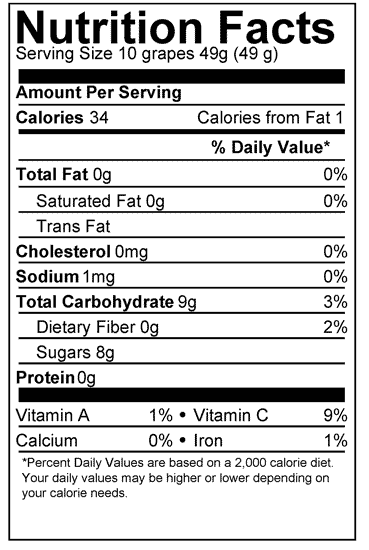How to read a nutrition label
Every packaged food that you pick up has to provide you with certain information by law. This information relates to the ingredients and nutritional value of the food, and can be found by reading the nutrition facts label, which is always clearly highlighted on the exterior of the packaging.
However, understanding nutrition labels is not something that everybody is comfortable with. If you are one of the many people out there who is interested in learning how to read a nutrition label, this page will really help you out.
Understanding nutrition labels
When you look at a nutrition fact label what do you see? A bunch of facts and figures, and a few nutrients that you may be familiar with. What does it all mean though? Let's now take a look at an example and go over how reading a food label needn't be so hard.

Starting from the top what you are seeing is the serving size of the product in question. This will tell you in grams the weight of the food that is contained in the package. The example shows a 49 g serving of grapes. It also states that there are 10 grapes in this particular serving size.
The information that follows on the food label relates to that exact weight of the product.
There are 34 calories in this serving of grapes, and only 1 of these calories comes from the fat found in them. Calories come from different parts of a food, for example the sugar or the carbohydrates. The fat content of grapes is incredibly low, so this is why only one of the total calories in this serving size comes from the fat.
The '% daily value' has a * next to it, and this is explained at the foot of the label. It means the following percentages are based on a 2,000 calorie daily diet (average adult male), and that the values can vary slightly due to your calorie needs. So for a child who needs less calories and nutrients for instance, the percentage would likely be higher. The percentages next to the nutrients shown are basically of the total that somebody on a 2,000 calorie diet would need per day. This serving of grapes would provide the consumer with less than a gram of dietary fiber, but the small amount still works out as 2% of the total fiber needed in a day. It also provides the consumer with 9% of their total vitamin C need per day, again if they are on a 2,000 calorie diet.
To find out how many calories you should be consuming each day, click here. Also to find out how much of each of the important nutrients that your body needs each day, click here for our vitamins and minerals index, where each is highlighted.
Again just to be clear, the daily values shown when reading a nutrition fact label vary depending on you as an individual. The factors that determine your nutritional needs are primarily your age and gender, alongside any specific medical dispositions, and your calorific need depends on age, gender, height, weight and activity levels.
Don't think that reading labels won't necessarily apply to you though, the percentages are potentially going to differ by a few points, and that is it.
Reading a nutrition label - What to look out for
The most obvious thing for most people when they are reading nutrition labels is to look out for the calories. Generally the more calories in a food the more chance there is of somebody health conscious avoiding it. Although you should note that it is better to eat natural and nutritious foods that may be relatively high in calories, such as raisins, over empty calorie foods like sodas and junk food.
There are three things in your diet that you should be monitoring and these are saturated fat, sodium and cholesterol. One of the main reasons you should be looking at how to read nutrition labels, is to be able to recognise how much of these are in the foods that you eat. Whereby sodium is critically important to your body, too much of it can lead to a number of health problems, as can too much cholesterol (something your body already creates naturally) and saturated fat.
Whereby it may be good to see a high percentage next to something like vitamin C on a nutrition label, seeing a high percentage next to saturated fat, sodium or cholesterol is a warning sign, and why it is so important that you know how to read the nutritional information of a product.
More information
We hope that this page has been able to help you when you are reading nutrition labels.
You can find out all about the nutritional and calorific value of the foods in your diet by checking out the hundreds that we have featured on the site, all of which can be found via the easy to use menus on the left hand side of the page.
Please take a few seconds to like and recommend the site to your friends, using the social buttons at the top of the page.
If you have any feedback or think that we have missed something on how to read nutrition labels, please feel free to get in contact with us on twitter and facebook pages.